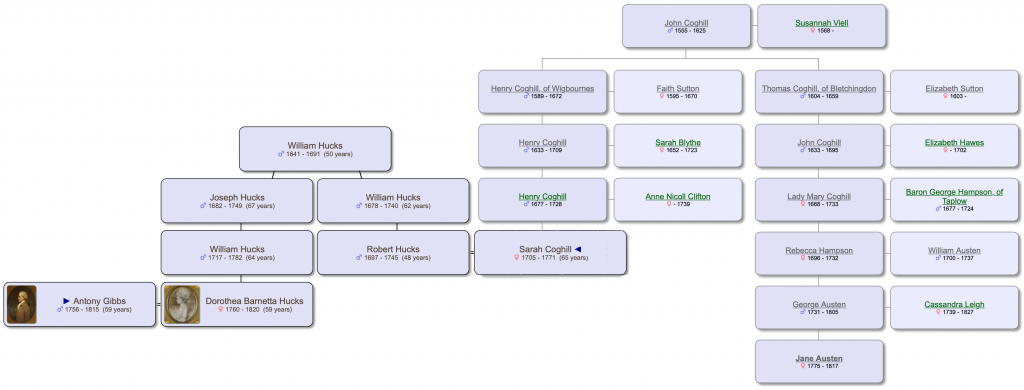Many routes to Jane Austen ?
I have recently been running a well attended course on genealogy at the University of the 3rd Age in Cambridge (U3AC) which has prompted me to research many aspects of the subject. It soon becomes evident that we are nearly all ‘cousins’ of some dimension, and that there may be various routes connecting each of us. If you consider that you have 2 parents, 4 grandparents, 8 great-grandparents etc., by the time you get back to the era of William the Conqueror this doubling mathematical series comes to over 8 billion, many times the global population a millennium ago. But we keep marrying cousins and humanity is incredibly inbred. Genomic data places the genetic isopoint (when we share every ancestor in common) for people of recent European descent at around A.D. 1000. This doesn’t however stop us from being intrigued about our specific ancestral connections!
A historian cousin, Nicholas, recently informed me that he had noticed that Jane Austen, the famous novelist, had a great grandmother Mary Coghill, daughter of John Coghill. Could there be a connection? I wrote a blog some time ago about “Henry Hucks’ fortuitous inheritances and interesting connections” showing how he had come to inherit iconic family estates, including Aldenham House and Clifton Hampden, from a distant 3rd cousin spinster, which had passed down through the Hucks, Noyes, Coghill and Sutton families. Was Jane Austen descended from the same Coghill family that had owned the Aldenham estate?
The Coghills originated from Coghill Hall, near Knaresbrough in Yorkshire, where the Hucks family of Dorothea, Antony Gibbs’ wife, were brewers and wine merchants. A younger son, John Coghill, moved south and became a merchant in London, marrying Susannah Viell, the daughter of a French couple, with whom he had 2 sons, Henry and Thomas, who married Sutton sisters.
Henry Coghill moved to Aldenham where he was believed to have resided at an older house called Penne’s Place, and was Sheriff of Hertfordshire in 1632. Neighbouring Wigbournes came to him through his wife Faith Sutton, later being named Aldenham House. Henry’s great-granddaughter Sarah Coghill married Robert Hucks, a first cousin once removed of Dorothea.
The younger son Thomas Coghill acquired a large lordship at Bletchingdon near Oxford and was knighted at Woodstock in 1633. His daughter, Faith, married Sir Christopher Wren, the architect of St Paul’s cathedral and numerous London churches. It is Thomas’s granddaughter Mary Coghill who was the great grandmother of Jane Austen.


Familysearch.com, the genealogy website of “The Church of Jesus Christ of Latter-day Saints”, or Mormons, based out of Salt Lake City in Utah, has been a leader in family trees (hoping to save your ancestors at the day of judgement). One of the options they provide is to show your relationship to famous people (predominately Americans, but not all).
They show a completely different relationship route between me and Jane Austen, going via Mary Coghill’s husband Baron George Hampson.
I tried another genealogy site which helps to trace distant relationships, geni.com. This showed a route which also went via George Hampson rather than the Coghills, but travelled though my South African mother’s family and her early North American settlers in 1600s before making its way back to England.
I am sure that there are other routes, but there is one which does not appear in the “accepted” histories of English families!
Was Jane Austen secretly married?
D’Arcy Wentworth was my 4th Great-Grandfather (I have 32 of them) on my father’s mother’s side. He was the first paying passenger to travel to Australia, on the notorious 2nd Fleet in 1790. He travelled to the new colony as a surgeon, having been found “not guilty” of 3 charges of highway robbery at The Old Bailey. He befriended a convict woman and their son was born onboard ship off Norfolk Island; it was a long arduous journey to Australia! William grew up to become one of the most influential figures in early colonial New South Wales.
A story passed down through the Wentworth family was that D’Arcy’s true love was Jane Austen; a descendent recently researched this story, and the true love story of “Jane & D’Arcy” was published in two volumes in 2017.
The liaison is vehemently denied by the Austen family and Jane Austen Society; all her letters from this period of her life were destroyed!

The ‘Wentworth version’ of events recounts …
In September 1789, D’Arcy Wentworth and Jane Austen, invited by Earl Fitzwilliam, attended a huge garden party at Wentworth Woodhouse in honour of the Prince of Wales. After the event, the couple left for Scotland, where they were married under Scottish law, that unlike England, did not require parental consent or the posting of marriage banns. After their return to London at the end of October, Wentworth was arrested and held at Newgate on suspicion of highway robbery. Tried and released on 9 December 1789, three days later he went to Portsmouth to arrange their passage to New South Wales on the Neptune.
Jane and D’Arcy spent Christmas with her family at Steventon, in Hampshire. Reverend Austen agreed to legalise their Scottish marriage, to marry them under English law, by special license. When James, his eldest son, arrived home from Oxford and reported what he had read in the London papers about Wentworth’s trial, Reverend Austen changed his mind. He convinced Jane her relationship with D’Arcy would damage her family’s reputation and the future prospects of her five brothers. He persuaded her to remain at home. Her family closed ranks around her, she remained confined within their orbit.
Neither Jane Austen nor D’Arcy Wentworth ever remarried. D’Arcy Wentworth sailed from Portsmouth on 17 January 1790.
D’Arcy never returned to England!

Superb blog and confirms a lot of information re the Gibbs Family